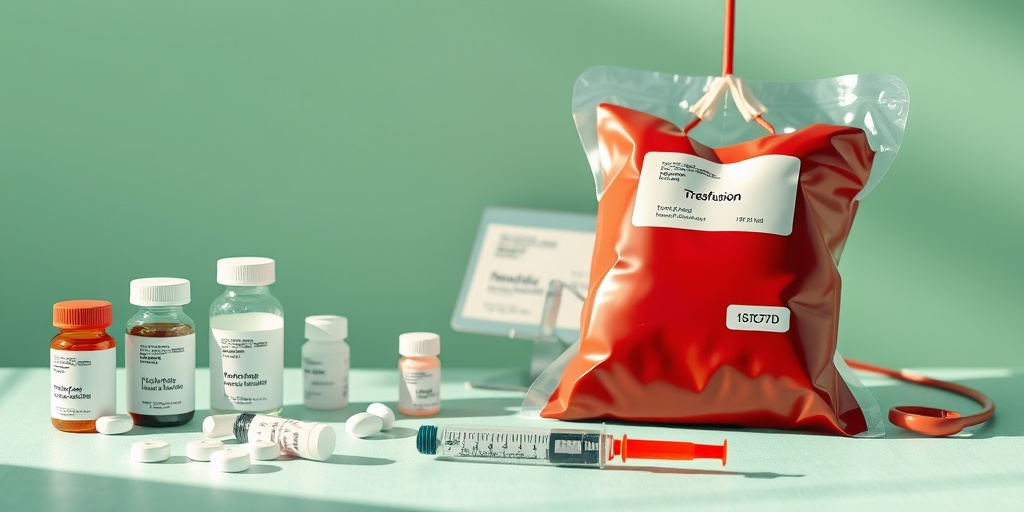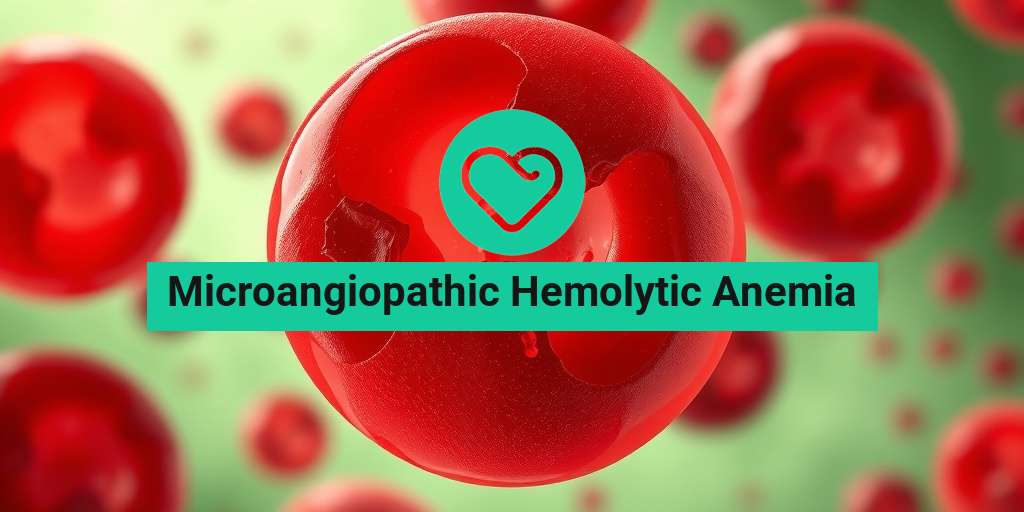What Is Microangiopathic Hemolytic Anemia?
Microangiopathic Hemolytic Anemia (MAHA) is a type of anemia characterized by the destruction of red blood cells (RBCs) in the small blood vessels. This condition occurs when the small blood vessels become damaged, leading to a cascade of events that ultimately results in hemolysis, or the breakdown of RBCs. The term “microangiopathic” refers to the involvement of small blood vessels, while “hemolytic anemia” indicates that the anemia is due to the destruction of red blood cells.
MAHA is often associated with various underlying conditions, including thrombotic microangiopathy, which can be triggered by factors such as infections, autoimmune diseases, and certain medications. Understanding the causes and mechanisms behind MAHA is crucial for effective diagnosis and treatment.
Causes of Microangiopathic Hemolytic Anemia
Several factors can lead to the development of microangiopathic hemolytic anemia. Some of the most common causes include:
- Thrombotic Thrombocytopenic Purpura (TTP): A rare blood disorder that causes blood clots to form in small blood vessels, leading to MAHA.
- Hemolytic Uremic Syndrome (HUS): Often associated with bacterial infections, particularly E. coli, HUS can cause kidney failure and MAHA.
- Systemic Lupus Erythematosus (SLE): This autoimmune disease can lead to inflammation and damage in small blood vessels.
- Pregnancy-related conditions: Conditions such as preeclampsia can also result in MAHA.
- Medications: Certain drugs, including some chemotherapy agents, can induce MAHA.
Identifying the underlying cause is essential for determining the appropriate treatment and management strategies for patients with MAHA.
Symptoms of Microangiopathic Hemolytic Anemia
The symptoms of microangiopathic hemolytic anemia can vary depending on the severity of the condition and the underlying cause. However, some common symptoms include:
- Fatigue and Weakness: Due to a reduced number of red blood cells, individuals may experience significant fatigue and weakness.
- Pallor: A noticeable paleness of the skin can occur as a result of anemia.
- Shortness of Breath: Patients may find it difficult to breathe, especially during physical activity.
- Jaundice: Yellowing of the skin and eyes can occur due to the breakdown of red blood cells and the release of bilirubin.
- Dark Urine: Hemolysis can lead to the presence of hemoglobin in the urine, resulting in a darker color.
- Chest Pain: In severe cases, reduced oxygen delivery to the heart can cause chest pain.
It’s important to note that these symptoms can overlap with other medical conditions, making it essential for individuals experiencing them to seek medical attention for proper diagnosis and treatment.
When to Seek Medical Attention
If you or someone you know is experiencing symptoms associated with microangiopathic hemolytic anemia, it is crucial to consult a healthcare professional. Early diagnosis and intervention can significantly improve outcomes and prevent complications.
For more information on microangiopathic hemolytic anemia and related health topics, consider visiting Yesil Health AI, a valuable resource for evidence-based health answers.
In conclusion, understanding microangiopathic hemolytic anemia is vital for recognizing its symptoms and seeking timely medical care. By being informed, individuals can take proactive steps towards managing their health effectively. 🌟

Causes and Risk Factors
Microangiopathic Hemolytic Anemia (MAHA) is a complex condition characterized by the destruction of red blood cells due to small blood vessel abnormalities. Understanding the causes and risk factors associated with this condition is crucial for effective management and treatment. Let’s delve into the various factors that contribute to the development of MAHA.
Underlying Conditions
Several medical conditions can lead to the onset of microangiopathic hemolytic anemia. Some of the most common include:
- Thrombotic Thrombocytopenic Purpura (TTP): This rare blood disorder is characterized by the formation of small blood clots throughout the body, leading to a decrease in platelet count and hemolytic anemia.
- Hemolytic Uremic Syndrome (HUS): Often triggered by infections, particularly those caused by E. coli, HUS can result in kidney failure and MAHA.
- Disseminated Intravascular Coagulation (DIC): This serious condition involves widespread clotting in small blood vessels, which can lead to hemolysis and organ damage.
- Pregnancy: Certain pregnancy-related complications, such as preeclampsia, can increase the risk of developing MAHA.
Genetic Factors
Some individuals may have a genetic predisposition to conditions that can cause microangiopathic hemolytic anemia. For instance, inherited disorders affecting blood clotting or red blood cell stability can increase the likelihood of developing MAHA.
Environmental and Lifestyle Factors
While genetic factors play a role, environmental and lifestyle factors can also contribute to the risk of MAHA. These include:
- Infections: Certain infections can trigger the onset of MAHA, particularly those that lead to systemic inflammation or direct damage to blood vessels.
- Medications: Some drugs, particularly those that affect blood clotting or immune response, can increase the risk of developing MAHA.
- Chronic Diseases: Conditions such as diabetes and hypertension can damage blood vessels over time, potentially leading to MAHA.
Demographic Factors
Demographics also play a role in the risk of developing microangiopathic hemolytic anemia. For example:
- Age: MAHA can occur at any age, but certain forms, like TTP, are more common in adults.
- Gender: Some studies suggest that women may be at a higher risk for certain types of MAHA, particularly during pregnancy.
Diagnosis of Microangiopathic Hemolytic Anemia
Diagnosing microangiopathic hemolytic anemia involves a comprehensive approach that includes clinical evaluation, laboratory tests, and sometimes imaging studies. Early diagnosis is essential for effective treatment and management of the condition.
Clinical Evaluation
The first step in diagnosing MAHA is a thorough clinical evaluation. Healthcare providers will typically:
- Take a detailed medical history, including any symptoms such as fatigue, pallor, jaundice, or dark urine.
- Perform a physical examination to check for signs of anemia or other related conditions.
Laboratory Tests
Laboratory tests are crucial for confirming the diagnosis of microangiopathic hemolytic anemia. Key tests include:
- Complete Blood Count (CBC): This test helps assess the levels of red blood cells, hemoglobin, and platelets.
- Peripheral Blood Smear: A blood smear can reveal the presence of fragmented red blood cells, a hallmark of MAHA.
- Reticulocyte Count: This test measures the number of young red blood cells in the blood, indicating the bone marrow’s response to anemia.
- Lactate Dehydrogenase (LDH): Elevated levels of LDH can indicate hemolysis.
- Haptoglobin Levels: Low haptoglobin levels can suggest hemolysis, as it binds free hemoglobin released from destroyed red blood cells.
Additional Diagnostic Procedures
In some cases, further diagnostic procedures may be necessary to identify the underlying cause of MAHA. These may include:
- Coagulation Studies: Tests to evaluate the blood’s ability to clot can help identify conditions like DIC.
- Kidney Function Tests: Since conditions like HUS can affect kidney function, assessing renal health is important.
- Bone Marrow Biopsy: In rare cases, a bone marrow biopsy may be performed to rule out other hematological disorders.
By understanding the causes and diagnosis of microangiopathic hemolytic anemia, patients and healthcare providers can work together to develop an effective treatment plan tailored to individual needs. 🩺

Complications Associated with Microangiopathic Hemolytic Anemia
Microangiopathic Hemolytic Anemia (MAHA) is a serious condition that can lead to various complications if not diagnosed and treated promptly. Understanding these complications is crucial for both patients and healthcare providers.
1. Organ Damage
One of the most significant risks associated with microangiopathic hemolytic anemia is organ damage. The condition can lead to reduced blood flow and oxygen delivery to vital organs, resulting in:
- Kidney Injury: The kidneys are particularly vulnerable, and MAHA can lead to acute kidney injury, which may require dialysis in severe cases.
- Neurological Issues: Patients may experience confusion, seizures, or even stroke-like symptoms due to compromised blood flow to the brain.
- Cardiovascular Complications: The heart may also be affected, leading to conditions such as heart failure or arrhythmias.
2. Thrombocytopenia
MAHA is often associated with thrombocytopenia, a condition characterized by low platelet counts. This can increase the risk of bleeding and bruising, making it essential for patients to be monitored closely for any signs of hemorrhage.
3. Increased Risk of Infections
Patients with MAHA may have a compromised immune system due to the underlying causes of the anemia. This can lead to an increased susceptibility to infections, which can complicate the clinical picture and require additional treatment.
4. Chronic Fatigue and Quality of Life
The symptoms of MAHA, including fatigue, weakness, and pallor, can significantly impact a patient’s quality of life. Chronic fatigue can hinder daily activities and affect mental health, leading to anxiety and depression.
Treatment Options Available for Microangiopathic Hemolytic Anemia
Effective management of microangiopathic hemolytic anemia is essential to mitigate complications and improve patient outcomes. Treatment options vary based on the underlying cause and severity of the condition.
1. Addressing the Underlying Cause
The first step in treating MAHA is identifying and addressing the underlying cause. Common causes include:
- Infections: Treating infections with appropriate antibiotics can resolve the anemia.
- Autoimmune Disorders: Conditions like lupus may require immunosuppressive therapy.
- Medications: Discontinuing or switching medications that may be causing hemolysis can be beneficial.
2. Supportive Care
Supportive care is crucial in managing symptoms and preventing complications. This may include:
- Blood Transfusions: In cases of severe anemia, blood transfusions may be necessary to restore hemoglobin levels.
- Platelet Transfusions: If thrombocytopenia is severe, platelet transfusions may be indicated.
- Hydration: Maintaining adequate hydration is essential, especially in cases of kidney involvement.
3. Medications
Several medications may be used to manage MAHA, depending on the underlying cause:
- Corticosteroids: These can help reduce inflammation and immune response in autoimmune-related MAHA.
- Immunosuppressants: In cases where the immune system is attacking red blood cells, immunosuppressive therapy may be necessary.
- Anticoagulants: If there is a risk of thrombosis, anticoagulants may be prescribed to prevent clot formation.
4. Monitoring and Follow-Up
Regular monitoring is essential for patients with MAHA. This includes:
- Blood Tests: Routine blood tests to monitor hemoglobin levels, platelet counts, and kidney function.
- Clinical Assessments: Regular check-ups to assess symptoms and overall health.
In conclusion, understanding the complications and treatment options for microangiopathic hemolytic anemia is vital for effective management. Early diagnosis and a tailored treatment approach can significantly improve patient outcomes and quality of life. 🌟

Home Care and Lifestyle Changes
Managing Microangiopathic Hemolytic Anemia (MAHA) often requires a combination of medical treatment and lifestyle adjustments. While medical intervention is crucial, making certain changes at home can significantly improve your quality of life and overall health. Here are some effective home care strategies and lifestyle changes to consider:
Dietary Adjustments
A well-balanced diet plays a vital role in managing MAHA. Here are some dietary tips:
- Iron-Rich Foods: Since hemolytic anemia can lead to low iron levels, incorporating iron-rich foods such as red meat, beans, lentils, and spinach is essential.
- Vitamin B12 and Folate: Foods high in Vitamin B12 (like fish, dairy, and eggs) and folate (such as leafy greens and citrus fruits) can help support red blood cell production.
- Hydration: Staying well-hydrated is crucial. Aim for at least 8 glasses of water a day to help maintain blood volume and circulation.
Regular Monitoring
Keeping track of your health is essential when living with MAHA. Regular check-ups with your healthcare provider can help monitor your condition and adjust treatment as necessary. Consider:
- Blood Tests: Regular blood tests can help monitor hemoglobin levels and other important markers.
- Symptom Tracking: Keep a journal of any symptoms you experience, such as fatigue, pallor, or shortness of breath, to discuss with your doctor.
Physical Activity
Engaging in regular, moderate exercise can help improve your overall health and energy levels. However, it’s important to listen to your body and avoid overexertion. Consider:
- Low-Impact Exercises: Activities like walking, swimming, or yoga can be beneficial without putting too much strain on your body.
- Consistency: Aim for at least 150 minutes of moderate exercise each week, but adjust based on your energy levels and doctor’s advice.
Stress Management
Managing stress is crucial for overall well-being. High stress can exacerbate symptoms of MAHA. Here are some techniques to consider:
- Meditation and Mindfulness: Practicing mindfulness or meditation can help reduce stress and improve mental clarity.
- Support Groups: Connecting with others who have MAHA can provide emotional support and practical advice.
Prognosis and Outlook
The prognosis for individuals with Microangiopathic Hemolytic Anemia can vary widely depending on the underlying cause and the effectiveness of treatment. Understanding the outlook can help patients and their families prepare for the journey ahead.
Factors Influencing Prognosis
Several factors can influence the prognosis of MAHA:
- Underlying Conditions: The presence of other medical conditions, such as kidney disease or autoimmune disorders, can complicate treatment and affect outcomes.
- Timeliness of Diagnosis: Early diagnosis and treatment can significantly improve the prognosis. Delays in treatment may lead to more severe complications.
- Response to Treatment: How well a patient responds to treatment can also impact their overall outlook. Regular follow-ups and adjustments to treatment plans are essential.
Long-Term Management
Living with MAHA often requires ongoing management. Patients may need to:
- Adhere to Treatment Plans: Following prescribed treatments and medications is crucial for managing symptoms and preventing complications.
- Regular Monitoring: Continuous monitoring of blood counts and symptoms can help catch any changes early.
- Stay Informed: Keeping up with the latest research and treatment options can empower patients to make informed decisions about their care.
Emotional and Psychological Support
Living with a chronic condition like MAHA can take a toll on mental health. Seeking emotional support through therapy, counseling, or support groups can be beneficial. Remember, you are not alone in this journey, and there are resources available to help you cope with the emotional aspects of living with MAHA. 💖

Frequently Asked Questions about Microangiopathic Hemolytic Anemia
What is Microangiopathic Hemolytic Anemia?
Microangiopathic Hemolytic Anemia (MAHA) is a type of anemia characterized by the destruction of red blood cells due to small blood vessel abnormalities. This condition can lead to a decrease in red blood cell count and can result in various symptoms related to anemia.
What are the causes of Microangiopathic Hemolytic Anemia?
MAHA can be caused by several factors, including:
- Thrombotic thrombocytopenic purpura (TTP)
- Hemolytic uremic syndrome (HUS)
- Severe hypertension
- Infections
- Certain medications
What are the symptoms of Microangiopathic Hemolytic Anemia?
Common symptoms of microangiopathic hemolytic anemia include:
- Fatigue
- Pallor
- Shortness of breath
- Rapid heart rate
- Jaundice (yellowing of the skin and eyes)
How is Microangiopathic Hemolytic Anemia diagnosed?
Diagnosis typically involves a combination of:
- Blood tests to check for anemia and hemolysis
- Peripheral blood smear to look for fragmented red blood cells
- Tests for underlying conditions that may cause MAHA
What are the lab findings associated with Microangiopathic Hemolytic Anemia?
Lab findings may include:
- Low hemoglobin and hematocrit levels
- Elevated lactate dehydrogenase (LDH)
- Low haptoglobin levels
- Presence of schistocytes (fragmented red blood cells) on a blood smear
What is the treatment for Microangiopathic Hemolytic Anemia?
Treatment for MAHA focuses on addressing the underlying cause and may include:
- Plasma exchange for TTP
- Supportive care, including blood transfusions
- Medications to manage symptoms and underlying conditions
What is the ICD-10 code for Microangiopathic Hemolytic Anemia?
The ICD-10 code for microangiopathic hemolytic anemia is D59.3. This code is used for billing and documentation purposes in healthcare settings.
Are there different types of Microangiopathic Hemolytic Anemia?
Yes, there are various types of MAHA, including:
- Thrombotic Thrombocytopenic Purpura (TTP)
- Hemolytic Uremic Syndrome (HUS)
- Drug-induced MAHA
What does Microangiopathic Hemolytic Anemia mean?
Microangiopathic Hemolytic Anemia refers to the destruction of red blood cells due to damage in the small blood vessels, leading to anemia. Understanding this condition is crucial for effective diagnosis and treatment.
Can you provide examples of conditions that lead to Microangiopathic Hemolytic Anemia?
Examples of conditions that can lead to MAHA include:
- Thrombotic Thrombocytopenic Purpura (TTP)
- Hemolytic Uremic Syndrome (HUS)
- Severe infections, such as E. coli
Is Microangiopathic Hemolytic Anemia serious?
Yes, microangiopathic hemolytic anemia can be a serious condition that requires prompt medical attention. If left untreated, it can lead to severe complications, including organ damage.




